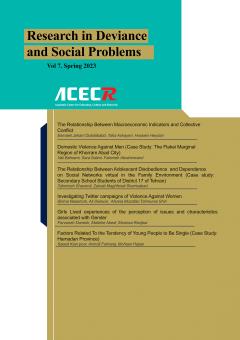-
-
-
Open Access Article
1 - Internal Migration and Social Security: A Study On Relationship Between Internal Migration Patterns and Social Insecurity in Iran
mahmoud moshfeghThe aim of this paper is to study the relationship between internal migration patterns and environment-oriented social security factors by pathological approach. The research method is the secondary analysis of census data; universe of study contains 31 provinces of the MoreThe aim of this paper is to study the relationship between internal migration patterns and environment-oriented social security factors by pathological approach. The research method is the secondary analysis of census data; universe of study contains 31 provinces of the country in year 2011.Based on the two percent census file, the sample contain 95093 migrated people. The theoretical framework of present article is social disorganization theory which extensively analysis the impacts of newly immigrants on the efficiency and ability of society for social controls. The results show that about 16 percent of the total internal migration, potentially pathological migrations (PMs). The destination of most PMs is Tehran, Hamadan, Razavi Khorasan and Alborz Provinces. Nearly 80 percent of PMs are between the 15 – 35 years old. Also, there was a significant positive correlation between PMs and the social environment insecurity index (r: 576, sig: 99. 9), But there was not a significant correlation between total net migration and PMs. According to the results, migration, by itself, not lead to the occurrence of social problems, but the quality of migrants and the mechanism of adaptation to the destination are contexts of social security. Manuscript profile -
Open Access Article
2 - The Role of Inequalities in Migration from Iran's Border Counties
Valiollah Rostamalizadeh Reza NobakhtThe role of regional and spatial inequalities, especially the role of inequalities in the border areas of the country, has been given less attention in the issue of migration. Although Iran's border areas have strategic importance from economic, social, and political as MoreThe role of regional and spatial inequalities, especially the role of inequalities in the border areas of the country, has been given less attention in the issue of migration. Although Iran's border areas have strategic importance from economic, social, and political aspects, and Ignoring paying less attention to these areas can have irreparable consequences in various sectors. This research aims to investigate the situation of Iran's border regions in terms of spatial inequalities and what effect these inequalities have on migration from these regions. In order to measure the spatial inequality among the border counties, the data of the general population and housing census of 2016 and other related findings have been used. Factor analysis has been used to weight and combine indicators and create spatial inequality. Arc Pro software was used for zoning and stratification of counties based on the dimensions of inequality and migration, and GWR statistical method was used to analyze the relationship between inequality and migration. The results show that inequality is higher in the eastern and southeastern counties compared to other places. Also, 66% of Iran's border counties have a negative migration balance. The geographically weighted regression model shows that 67% of the changes in the net migration variable are explained by independent variables, and based on the average value presented, the population structure factor and the economic factor have the greatest effect on the net migration in border counties. Also, the effectiveness of factors for migration is different in different regions of the country. Manuscript profile
List of Articles internal migration.
-
The rights to this website are owned by the Raimag Press Management System.
Copyright © 2017-2024

